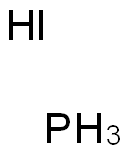Chemical Properties
large, transparent, colorless crystal(s); tetr; sublimes at room temp; decomposes to PH3 and HI when heated or in presence of alcohol or water; rapid heating causes detonation [MER06]
Uses
In the laboratory preparation of phosphine.
Physical properties
Colorless tetragonal crystal; deliquesces; density 2.86 g/cm3; sublimes at ordinary temperatures; vapor pressure 50 torr at 20°C, 760 torr at 61.8°C; melts at 18.5°C under its own vapor pressure; boils at 80°C; decomposes in water; soluble in acids and alkalies with decomposition; decomposes in ethanol.
Preparation
Phosphonium iodide may be prepared by the action of phosphine with dry hydrogen iodide:
PH3 + HI → PH4I
Solid phosphonium iodide may be produced in the laboratory by slowly and very cautiously adding water to an intimate mixture of white phosphorus and iodine. Also, this phosphorus-iodine mixture may be obtained by mixing solutions in carbon disulfide and carefully evaporating the solvent in a stream of inert gas:
P4 + I + H2O → PH4I + H3PO4
2P + I2 + 4H2O → PH4I + H3PO4 + HI
Also, the compound can be prepared by hydrolysis of a mixture of diphosphorus tetraiodide and white phosphorus:
P2I4 + P + H2O → PH4I + H3PO4.
Hazard
Phosphonium iodide detonates on rapid heating. It dissociates by water, alcohol or heat, evolving toxic phosphine gas.
